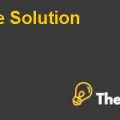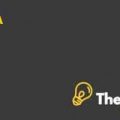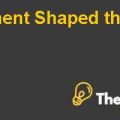Discount rates to be used for the computation of present value:
There are two appropriate discount rates that must be used while going through an investment appraisal. These two rates are different because the debt and equity rates are different as well as their ratios. The lower one will be used as the lower WACC can give higher returns to the shareholders and an unacceptable project can be accepted through this approach.
With 100% debt financing:
With 100% debt financing for this acquisition, it will definitely increase the beta equity and the required return of the shareholders due to increase in the financial risk.The beta asset is the systematic risk of operating in the industry and the economy and when the financial risk is incorporated into the beta asset, then the beta equity is derived.
The beta asset for the industry is 1.11 (appendix 1), and the beta equity for 100% debt financing is 2.43 (appendix 2). The risk free rate is 2.56% and the market risk premium is 5.9%. The combination of all these variable derives the cost of equity of 16.91%.
The cost of debt is different in this scenario as one debt is the existing debt of 43.8 million that is at 4.5% per annum and the net of tax cost of debt is 2.93% and the tax rate is 35% (appendix 3). The cost of debt for raising new debt of $120 million is 5.5% and net of tax cost of debt is 3.58%.
The debt and equity have their own percentages in the total value of the company that are given in appendix 3. The WACC through the combination of these and rates derives it 8.19%.
Thus, the rate that must be used to appraise the investment if the company has chosen to raise the debt of $120 million. In this calculation, the amount of equity is $90 million because the value of raised amount of $60 million in the next part represents 40% net value of the equity instruments of the company.
With 50% debt financing:
The debt financing is $60 million and another $60 million is raised through the equity that represents 40% holding in the company if the equity financing is taking place.
The beta equity through this arrangement is 2.56 and the cost of capital is 17.69% (appendix 4).
In this arrangement, the debt and equity weigh tages differ from that weigh tages in the last part because in this debt financing is lower. The cost of debt for new financing is 5% and net of tax it is 3.25%, the reason behind the reduced rate is that in the last case the debts amounted above $163 million and in this case it is around $123 million (appendix 6).
The WACC for this capital arrangement is 11.31% because of higher weigh tage of equity into it (appendix 6).
Weigh tage method suggested:
The suggested method is to finance the 100% debt because it seems to be more appropriate because the required return rate is lower than other section and it does not take the stake of Broadways to other investors because it is the sole owner of the group with this loan arrangement.
The problem with this is the loan repayment arrangement that requires a heavy cash repayment after some period, therefore it must go forward for a detailed plan that whether it is able to pay off the principle repayment commitments.
The present value of future cash flows with the view of a task force of managers analyzing the acquisition:
According to the future assumptions of a task force of managers, the present value of future cash flows of Landmark is $210.49 million (appendix 7) and it has shown a positive cash flow results for the Broadway Financials with an amount of $2.12 (appendix 8).
The combined present value of future cash inflows is $212.61 million that derives the NPV of $92.61 million (appendix 9).
It has taken many assumptions and the discount rate used for this calculation is 8.49% which is the rate of 100% debt financing that is suggested due to lower required return.
The present value is up for perpetuity that may not be possible because the company may not survive for perpetuity period, but it is assumption of free cash flow calculation methodology.
The free cash flows have assumed that WACC is same over the life of the company, but it is not true because it uses to change as a change in any of variation of beta equity and capital asset pricing model...............
This is just a sample partial case solution. Please place the order on the website to order your own originally done case solution.













